In this ted talk cinematographer and director Paul Atkins talks about storytelling from the heart vs. from the mind. And the different effects it has on the viewers. He especially talks about environmental film making and how different images and different kinds of storytelling have different impacts.
Category: Media Design
Design in Politics
If designers want to have the right to lead or even participate in the transformation of social systems, they have to develop a political competence, which, however, is often still lacking. Concepts, framework conditions, tools and, above all, a sensitivity must be developed in order to participate as a designer in the political dimension of society and to deal with it, to understand and question it. As in graphic design or product design, the designer has to learn a kind of vocabulary in order to familiarize himself with the field of knowledge and understand the needs and laws of politics – just not to remain a non-specialist in this field.
Design is political, that’s hardly a question these days. Many authors report on this fact again and again, whether Langdon Winner with his report on the discriminatory effects of the deep bridges in Long Island or Ruben Pater with his collection of examples in visual communication.

Everyone designs who devise courses of action aimed at changing existing situations into preferred ones. The intellectual activity that produces material artifacts is no different fundamentally from the one that prescribes remedies for a sick patient or the one that devises a new sales plan for a company or a social welfare policy for a state.
The Sciences of the Artificial, 1969 Herbert A. Simon
Like Eames, Herbert A. Simon describes design as a universal tool for all areas. Industrial design, medicine, business design, or government service design are all the same type of intellectual activity. Design thinking can address challenges in the entire area between material objects and social systems.
Design is what people do to reduce or eliminate the difference between the world as it is and what the desired state is. Political conflicts arise when there are different, competing interests and thus also ideas of the preferred system. If some actors consider the current system, or something similar, to be preferred, attempting to change that system can lead to conflict.
But political conflicts are not the only challenge that design in politics has to face. Another is the power aspect. At any point in time in any social system there is a different distribution of power among the social actors. This means that some of them will be able to either maintain the existing situation or determine which preferred situation suits their interests and realize such a preferred situation.
Every order is always an expression of a specific configuration of power relations.
Chantal Mouffe, Ernesto Laclau – Agonistics: Thinking the World Politically
This means that no design project targeting social systems takes place without a power factor. They are always trying to establish a new order in the social area, in which respect design and politics can no longer be distinguished.
It becomes possible in such a system to speak of the power of each actor, for power is a measure of the value within a system of the resources with which each actor begins (with that value itself deriving from the interests of other actors in these resources) and thus of the weight that the system applies to that actor’s interest in the aggregate satisfaction that is realized.
James S. Coleman – Foundations of Social Theory
Historical example of design in politics and society
The Nazi Aesthetics
Design is often seen as a contribution to creating a better world. But it can be used very well for propaganda purposes. In Nazi times, the design of all things was subject to a regime-stabilizing objective, that is, every design was careful to present the government in a positive and embellishing way. It is also said that there was no innocent design.
The history of design therefore consists of re-occurring subject matter representing moral correctness. However, design reflects the whole of the world, with all its good and bad sides. The Nazis were masters in using design to achieve their goal, to both convince and destroy huge numbers of people.
Designmuseum Den Bosch, NL
Design during the Third Reich was essentially contradictory. The main theme was purity, which meant that various population groups such as Jews, homosexuals and Roma had to be exterminated. National Socialism developed and relied on its own history, but at the same time focused fanatically on the future. It was full of romance, but also obsessed with modern technology. For the outside world, National Socialism presented a seductive picture of prosperity and carefree entertainment, while the first concentration camps were established in 1933.
On November 27, 1933, the “Amt der Schönheit” was founded. The tasks included the beautification of workplaces, the improvement of working conditions, ergonomics and occupational safety. At least, these were the obvious tasks. In fact, changes served to increase productivity, the increased exploitation of labor and means of production, the advance of a Nazi national community of leadership and workforce, and the saving of metals, which should be reserved for the armaments industry.
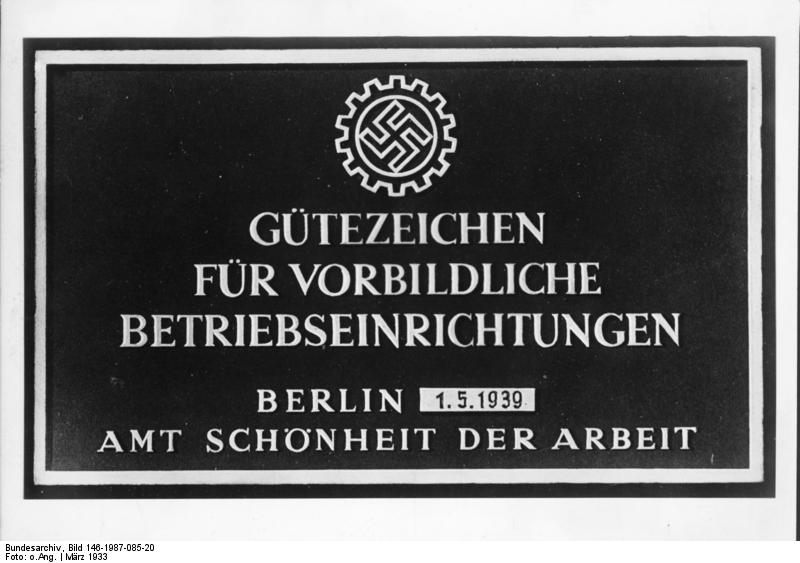
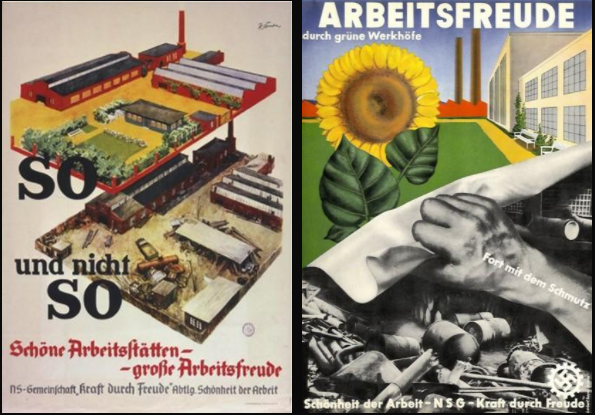
In the case of graphics, the influence of the communist propaganda aesthetic on National Socialists can be traced, whose imagery, for example, is still used by the North Korean regime today. Through the combination of text and graphics, the poster became an important medium for propaganda at the time. The use of Fraktur was common in Germany until 1941. Modern sans serif fonts have been condemned as cultural Bolshevism. The images were often based on heroic realism: the National Socialist youth and the SS were depicted monumentally, with the lighting bringing out the size.
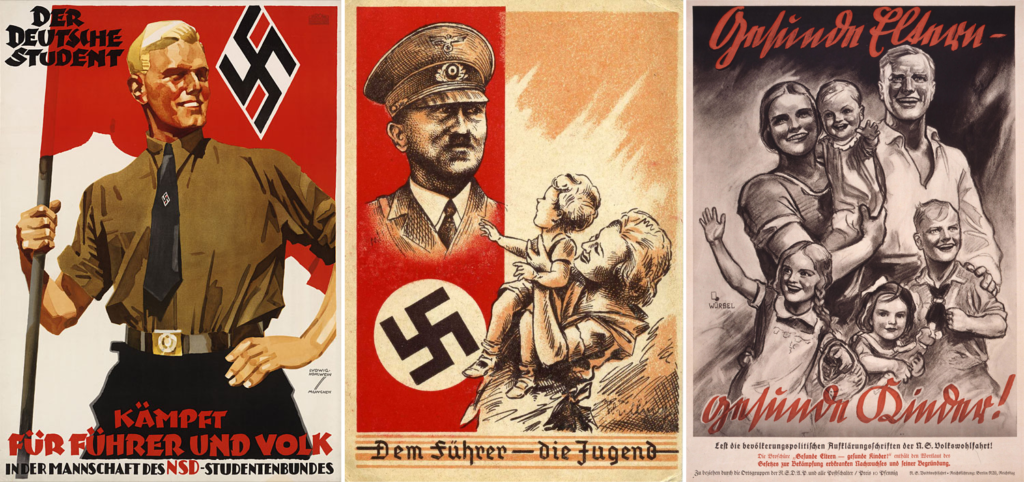
Current example of design in politics and society
Black Lives Matter Movement
The aim of a protest is always to clearly draw attention to a maladministration. And these moments of protest, of disagreement with the situation should not remain moments, but rather stay in the mind and change something.
Traditionally, art has supported protests by creating posters, t-shirts and pins with impactful messages and eye-catching graphics. Currently, whether due to corona restrictions or the increasingly digital world, one sees a different tenor of social activism, especially on Instagram.
Movement guides appear, instructions for virtual protesting, reading black authors, unlearning the white savior, and many more. These guides are not just about expanding the visual landscape of a moment of protest, but also finding a way forward and asking: what’s next? And this question is asked precisely to those with privileges and power.
So the question is how can we continue sharing but do it in an effective way? We have to think about our target audience (the oppressor) and where they hang out virtually. We have to use their hashtags to meet them virtually.
Manassaline Coleman on Instagram https://www.instagram.com/p/CAyFgY6jdE0/
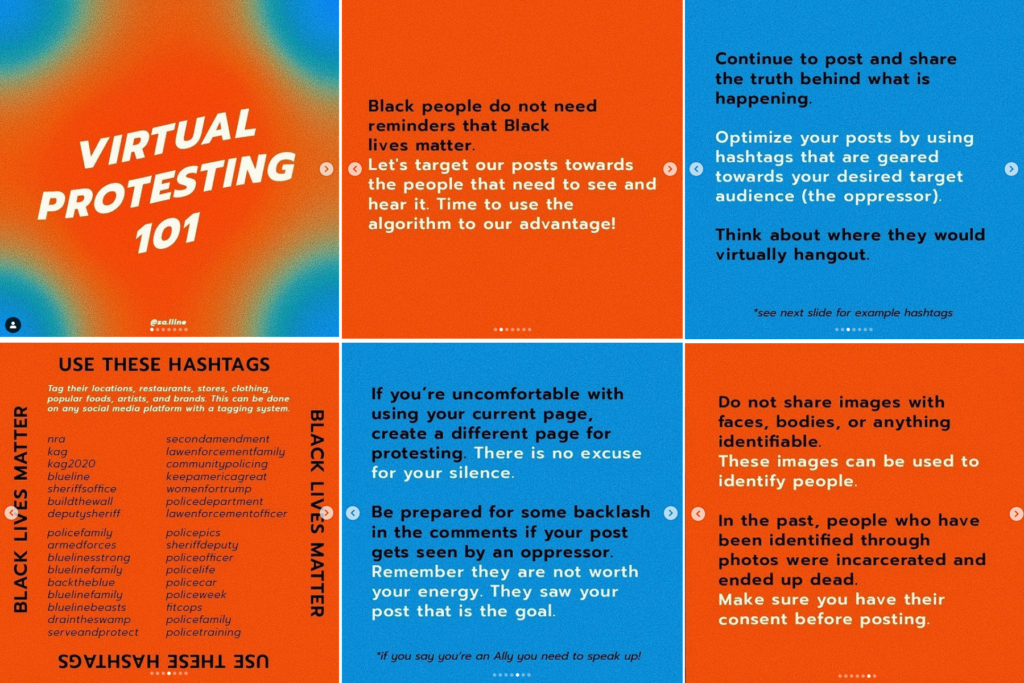
While there are specific measures to defuse and abolish the police force, these demands are being addressed by advocates, activists, policymakers, bureaucrats and the courts. The changes requested by the design community require more personal forms of accounting if there are no legal provisions. They require recognition and accounting with undeserved privileges and powers. The demand for humanity and justice; the right to have the same vote in decision-making.
The designers who created Movement Guides demand that colleagues in privileges and powers equally grapple with these ideas about who you are and what privileges you have. The goal is to mutually change and allow yourself to be changed. Trying to say and do the right things. Clear, understandable but above all factually correct to communicate and protest and thus to bring about changes.
Boundaries of Design
In order to determine where the limits of design actually are, I first looked at how design is difined. Charles Eames describes design as follows:
One could describe “Design” as a plan for arranging elements to achieve a particular purpose.
Charles Eames
Eames does not see design in this case as the arrangement of certain elements, but much more as a plan for the arrangement of the elements. A design can therefore be applied, copied and reproduced over and over again. If you research the Eames, it quickly becomes clear that they will be remembered for their chairs, but their work contained many other areas such as toys, tools, radios, buildings, films, exhibitions and much more. This alignment already shows that design is something universal for the Eames. Something that can be applied to very different areas of life and not just to one sub-area.
Later in the video, Eames answers the question about the limits of design with the counter-question about the limits of problems. According to Eames, there can also be design wherever there are problems.
Design has continued to evolve over time. From an approach that is primarily interested in the arrangement of objects to an increasingly strategic approach. Newer design approaches such as experiential design, service design, business design, organizational design and system design have emerged and deal with problems that are becoming more and more abstract. In these areas, design is linked to social responsibility. So the limits to which design was restricted have also widened.
When design is about creating better future prospects for people, we do it because we, as humans, are interested in change the world towards desirable scenarios. Design and its limits can be changed with society. But I think that the other way around, society can also be changed by shifting the boundaries of design.
AR in the digital market place
There were numerous AR Festivals in 2020. In this post I want to present two examples hostet by AcuteArt – an digital marketplace for Augmented reality artworks.
Unreal City, London´s biggest AR festival in 2020 was extended until February 2021. It consists of 36 AR works from artists all over the globe including never before seen pieces from KAWS, Tomás Saraceno and many more. Initally the virtual sculptures were placed at specific positions in London, due to the COVID pandemic they can bee seen all over the world – even in your living room!
The AR pieces can been seen through Acute Art app.



“When I realized the quality that could be achieved and experienced in AR, I was immediately drawn to its potential (…) ” – KAWS
The AR exhibition “Expanded Holiday” opened in March 2020 and could be seen with the Acute Art App across eleven locations—Doha, Hong Kong, London, Melbourne, Paris, Sao Paulo, Seoul, Taipei, Serengeti National Park, Tokyo, and New York City.


Londoner Mastaba
For three months in 2018, the monumental sculpture was installed on top of the Serpentine Lake in London’s Hyde Park by artist Christo. Since the sculpture is gone it can be seen with via the Acute Art app. The London Mastaba AR offers art enthusiasts the opportunity to discover an exact virtual replica of the installation through their mobile phones when they visit the Serpentine Lake.
https://www.instagram.com/p/CCbQAWslXqE/?utm_source=ig_embed&utm_campaign=embed_video_watch_again
A potentially lucrative market
While Acute Art CEO Jacob De Geer said that his company “was founded on the vision of democratising art and bringing it to places where it could not be before,” there is huge potential for the commercialisation of AR artworks.
New Jersey-born street artist KAWS put this theory to the test in March 2020 with an ambitious AR project, which encompassed a public exhibition and the drop of two AR sculpture editions of his trademark “Companion” that are available for purchase on Acute Art’s app.

As for the editions, the first installment is comprised of 25 AR sculptures (1.8m) that will be available to acquire exclusively though the Acute Art website for $10,000 USD each. Users will be able to place, capture and document the ubiquitous KAWS subject at varying locations using the app. They can also make their documentation private or public with the option to resell the edition too. The second rollout is an open edition consisting of AR sculptures in three unique colorways that will release in various timeframes. Users will only be able to keep the works for 24 hours or 10 days and share their experience on social media. Prices start at $6.99 USD for one sculpture for 24 hours.
Owners are able to place, capture, and document these AR works, collectively named “COMPANION (EXPANDED),” at different locations using the Acute Art app. More surprisingly, they can keep the AR sculptures private, or make them publicly available for anyone who has downloaded the app.
Sources:
https://www.nowness.com/story/unreal-city-acute-art
https://www.archpaper.com/2020/03/kaws-worldwide-ar-exhibition/
https://hypebeast.com/2020/3/kaws-expanded-holiday-companion-augmented-reality-acute-art-app-info
Intercultural Communications 7
Transformation of acculturation during the second half 20th century and the beginning of 21st century
Acculturation means, assimilation to a new and different culture which happens mostly with the dominant culture. It may also impact social and psychological well-being.
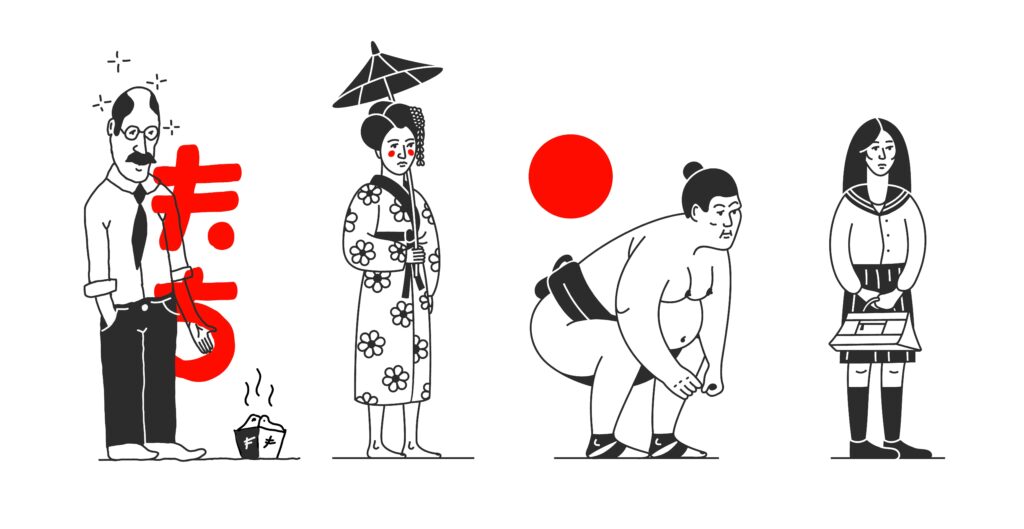
Since the beginning of the 90s the approach to acculturation studies, has been revised, which happened due to untied Germany. “…Two generations of Germans, brought up in different socio- cultural environments, and having very little opportunity to communicate with each other, after the unification of Germany had to face problems of acculturation” (Ushanova 2001: 4- 5). Russian speaking scientists have been facing different problems studying acculturation themes, due to the insufficient scientific/theoretical development of the acculturation concept.
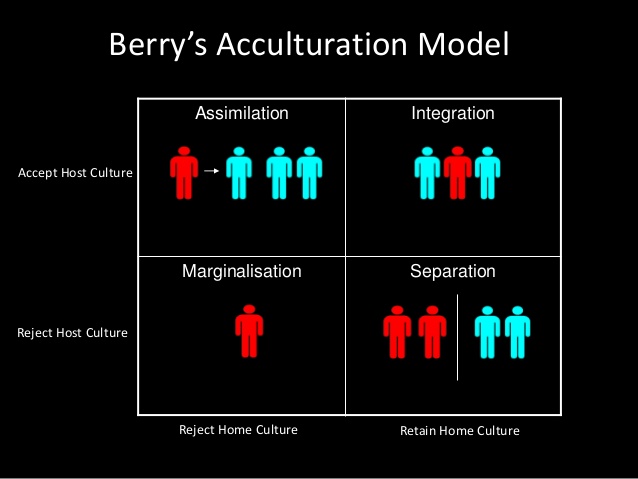
Along similar models to Berry, Natalia Vladislavovna Yankina examines the matter of tolerance in intercultural communications. Yankina describes acculturation as
“the process and result of the mutual influence of different cultures in which all or a part of the representatives of one culture (the recipient) adopt the norms, values and traditions of the other (donor)”.
Acculturation is a crucial factor in order to retain cultural identity while being (or becoming) engaged in another culture.
Researchers are studying various acculturation matters such as:
- Linguistic acculturation: During this process, the person masters a new language so that the new language changes his/her culture. The person uses the new language instead of his/her mother tongue communicating, living and fulfill the basic needs (Ushanova 2003, Perez 2011).
- Legal acculturation: interaction between legal cultures of different societies (Rulan 1988, Sokolsky 2014).
- Religious acculturation: interaction between religious cultures (Sobolev 2003, Awad 2010).
- Ethnic acculturation: interaction between ethnicities (Avdeeva & Bolotin 2016, Mashau 2012).
- Online acculturation: It is an intercultural interaction between people in the online platform, which has even created the new online culture. Online Platforms are vast area so that different people with different backgrounds can communicate with one another (Kosik2015).
- Psychological acculturation: interaction of an individual with another sociocultural environment (Graves 1967, Bochner 1982).
- Political acculturation: The changes of the political ideations and beliefs of a group while interacting or participating with different groups (Berry & Annis 1988, Iovan 2015).
“As a theoretical scientific category, acculturation research goes beyond academic discourse and is increasingly taken into account in political debates. Acculturation is becoming a reality that needs consideration in many political decisions. The present global social space is a world of worlds, where each component has its own cultural, ethnic, religious, and political peculiarities. Analysis of any specific form or model of acculturation involves further, specialized research”.
Ludmila Sokolskaya, Arturas Valentonis
Die letzte Instanz (8)

In der WDR Talkshow „Die letzte Instanz – Der Meinungstalk mit Steffen Hallaschka“[1] wird am 29.01.2021 unter anderem über die Frage diskutiert: “Das Ende der Zigeunersauce: Ist das ein notwendiger Schritt?”. Unter den geladenen Gästen Thomas Gottschalk, Micky Beisenherz, Jürgen Milski und Janine Kunze ist keine Person von Rassismus betroffen.
Steffen Hallaschka liest ein offizielles Statement des „Zentralrats deutscher Sinti & Roma“ vor:
„‘Zigeuner` ist eine von Klischees überlagerte Fremdbezeichnung der Mehrheitsgesellschaft, die von den meisten Angehörigen der Minderheit als diskriminierend abgelehnt wird – so haben sich die Sinti und Roma nämlich niemals selbst genannt.“
Auf der Webseite des Zentralrats Deutscher Sinti und Roma heißt es weiter:
„Die Durchsetzung der Eigenbezeichnung Sinti und Roma im öffentlichen Diskurs war von Anfang an ein zentrales Anliegen der Bürgerrechtsbewegung, die sich vor allem seit Ende der Siebzigerjahre in der Bundesrepublik formierte. Dadurch sollte zugleich ein Bewusstsein für jene Vorurteilsstrukturen und Ausgrenzungsmechanismen geschaffen werden, die im Stereotyp vom „Zigeuner“ ihre Wurzeln haben. […] Die Bezeichnung „Zigeuner“ hingegen ist untrennbar verbunden mit rassistischen Zuschreibungen, die sich, über Jahrhunderte reproduziert, zu einem geschlossenen und aggressiven Feindbild verdichtet haben, das tief im kollektiven Bewusstsein verwurzelt ist. Ab dem 16. Jahrhundert setzte sich in Deutschland die (irrige) Auffassung durch, „Zigeuner“ sei abgeleitet von „Ziehgauner“. Auch in einem der ersten Lexikonartikel zum Stichwort „Zigeuner“, 1848 im Brockhaus erschienen, wird dieser Zusammenhang explizit hergestellt. Dort findet man die ganze Palette negativer Stereotypen über unsere Minderheit aufgelistet, bis hin zu der Behauptung, „Zigeuner“ würden Kinder stehlen. Noch in der 2. Auflage des Dudens sinn- und sachverwandter Wörter aus dem Jahr 1986 wird unter dem Stichwort „Zigeuner“ auf die Begriffe „Abschaum“ und „Vagabund“ verwiesen.“ [2]
Bei der Diskussion „Die letzte Instanz“ wurden diskriminierende und respektlose Aussagen kundgetan. Dass die Fremdbezeichnung „Zigeuner“ im Nationalsozialismus als Kategorisierung genutzt wurde, um Menschen auszuschließen, zu verfolgen und zu deportieren, wurde nicht thematisiert. Es wurde kein Verständnis für die von Rassismus betroffenen Personen gezeigt und auch keine Meinung einer betroffenen Person vertreten.
Der WDR äußerte sich daraufhin mit folgendem Statement vor der Sendung in der Mediathek:

Die Schauspielerin Janine Kunze entschuldigte sich nach großer öffentlicher Empörung ihrer Aussagen auf der Plattform Instagramm:
„Ich habe den ganzen Tag darüber nachgedacht, die richtigen Worte zu finden in Bezug auf das, was ich in der Sendung gesagt habe und wie sich diejenigen fühlen, die ich damit verletzt habe. Es tut mir unendlich leid und ich habe festgestellt, dass ich nicht ausreichend aufgeklärt bin. Mir ist klar geworden, dass ich Menschen, insbesondere die der Sinti und Roma Community, mit meinen unbedachten Äußerungen zutiefst verletzt, als auch diskriminiert habe und dafür möchte ich mich aufrichtig entschuldigen. Gerade ich als Mutter von drei Kindern, sollte aufgeklärter sein, wenn es um unser vorurteilsbehaftetes Sprachsystem geht, für dessen Mitgestaltung wir alle verantwortlich sind. Ich werde zukünftig meine Wortwahl überdenken, denn es war falsch, dass ich mir angemaßt habe, als privilegierte weiße Frau über ein Thema zu sprechen, welches ich in seiner Konsequenz und in seinen Ausmaßen nicht beurteilen kann!“
Die WDR-Umfrage „Das Ende der Zigeunersauce: Ist das ein notwendiger Schritt?“ wurde mit 15,9 % mit „Ja“ und mit 84,1 % mit „nein“ beantwortet, mit dem Hinweis: Das Ergebnis dieser Umfrage ist nicht repräsentativ. Rundungsbedingt kann es zu Abweichungen kommen.“
Viele weitere Umfragen bestätigen, dass in unserer Gesellschaft, aber auch europaweit wenig Verständnis für Sinti und Roma entgegengebracht wird und eine offene Ablehnung dieser Minderheit herrscht.
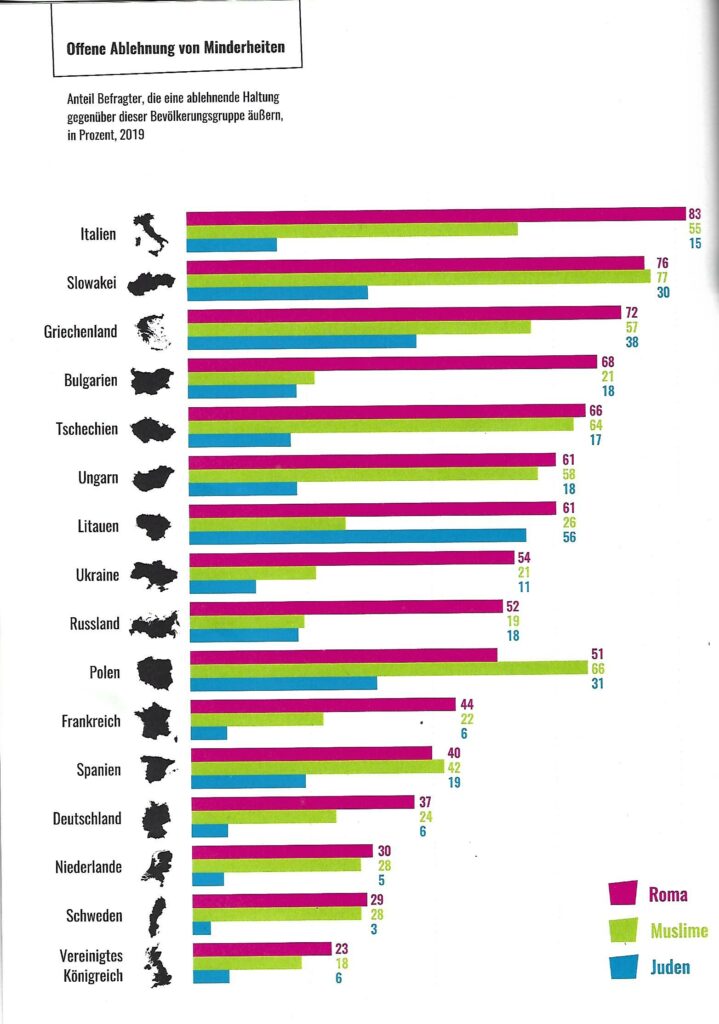
Dies zeigt, dass noch viel mehr geschichtliche Aufklärung notwendig ist.
1933 wurde mit dem „Gesetz zur Verhütung erkranken Nachwuchses“ die Zwangssterilisation von Sinti und Roma eingeleitet. Mit den Nürnberger Gesetze (15.09.1935) und dem „Blutschutzgesetz“ wurde die Überwachung, Aufenthaltsbeschränkung und Entrechtung der Sinti und Roma verstärkt. 1938 entstand die „Rassenhygienische und Bevölkerungsbiologische Forschungsstelle“. 1938 wurde die „Reichszentrale zur Bekämpfung des Zigeunerunwesens“ gegründet. Im Dezember 1938 erließ der SS-Chef H. Himmler den Befehl zur „Bekämpfung der Zigeunerplage“.[4]
Am 16.12.1942 ordnete Himmler mit dem „Ausschwitzerlass“ die Deportation von Sinti und Roma in die Vernichtungslager an. Der Porajmos[5] ist die Spitze der Verfolgung, bei dem rund 500.000 Roma und Sinti[6] ums Leben kamen.
Wer sich der geschichtlichen Diskriminierung und Verfolgung bewusst ist, weiß wie sensible dieses Thema ist und mit wie viel Kraft sich alle gegen die Diskriminierung von Sinti und Roma einsetzen müssen. Auch welchen Respekt wir Betroffenen entgegenbringen müssen, wenn über dieses Thema diskutiert wird.

Bildquelle: https://www.spiegel.de/kultur/tv/die-letzte-instanz-wdr-entschuldigt-sich-fuer-talkshow-zum-thema-rassismus-a-3ca6bd0d-0961-4f06-8776-ccd2126a1f8c [01.02.2021]
[1] WDR: https://www.ardmediathek.de/wdr/video/die-letzte-instanz-der-meinungstalk-mit-steffen-hallaschka/im-gespraech-mit-janine-kunze-und-thomas-gottschalk/wdr-fernsehen/Y3JpZDovL3dkci5kZS9CZWl0cmFnLTFhOGU1NDM3LWJkMGItNDE2NC1hZDdiLWE1ZjYyYzIyMDlhMQ/
[2] Zentralrat Sinti und Roma: https://zentralrat.sintiundroma.de/sinti-und-roma-zigeuner/ [01.02.2021]
[3] Katapult. N°19 Oktober bis Dezember 2020 S. 42
[4] Die Verfolgung der Sinti und Roma im Nationalsozialismus (geschichte-bewusst-sein.de)
[5] Vgl. https://www.romarchive.eu/de/voices-of-the-victims/genocide-holocaust-porajmos-samudaripen/
[6] Vgl. https://www.erinnern.at/gedenktage/internationaler-tag-des-gedenkens-an-den-genozid-an-sinti-und-roma
Romanes (7)
Roma-Gruppen überlieferten ihre Geschichten vor allem mündlich. Die alphabetische Schrift wurde vor dem 20. Jahrhundert zur Kommunikation mit Nicht-Rom_nja zu wirtschaftlichen und offiziellen Anliegen genutzt.
Zu Beginn des 20. Jahrhunderts begannen Schriftsteller*innen und Dichter*innen vermehrt ihre Werke schriftlich zu verfassen. Dies lag einem neuen Selbstbewusstsein zu Grunde, mit dem sich Rom_nja und Sinti_ze für eine kulturelle und politische Anerkennung und Eigenständigkeit einsetzen.[1] Themen waren vor allem die „Verfolgung, Diskriminierung und jahrhundertelang tradierte symbolische Repräsentationen.“[2]
Die Texte sind in der Sprache Romanes aber auch zahlreichen anderen Sprachen wie zum Beispiel Russisch oder Tschechisch verfasst.[3] Romanes ist mit dem indischen Sankrit[4] verwandt.
Mit der Gründung der Vereinigung der Roma-Schriftsteller wurde zwischen 1990 und 1992 „mehr Roma-Literatur veröffentlicht als in der ganzen 600-jährigen Geschichte der Roma auf dem Gebiet der Slowakischen und Tschechischen Republik“[5]. Zuvor wurde die „Verwendung [von Romanes] im öffentlichen Raum sanktioniert und […] von mehreren Roma selbst abgelehnt“.[6]
Die Welle der Romani-Literatur lies das „sprachliche und kulturelle Erbe […] revitalisieren“. [7] Teilweise wurden AutorInnen aber auch von Roma mit „traditionellen Sichtweisen“[8] kritisiert, da sie Themen wie Geschlechtergewalt aufarbeiteten.
Der Begriff Romani-Litaratur ist umstritten. Manche Autor*innen wollen sich der „Zugehörigkeit und Identifikation“ mit der „ethischen Identität“ entziehen, „da die Gefahr besteht, dass ihre Werke nur unter dem Blickwinkel „Roma-Literatur“ bzw. – exotisch – als ‚Zigeuner-Literatur` rezipiert und andere Komponenten ihres literarischen Werks vernachlässigt werden.“[9]
Wichtige Inhalte der Roma-Texte sind „romano čačipen (Wahrheit / Realität)“ ebenso wie das „Geheimnisvolles und Rätselhaftes“. [10] „Die Kraft eines Wortes wird in der traditionellen Roma-Gemein-schaft viel mehr geschätzt – ein Wort kann als guter oder böser Zauber wirken“.[11] Magische Wörter sind beispielsweise „jilo (Herz) / phuterel o jilo (das Herz öffnen), jekhetane (zusammen), phrala (Brüder), manuš (Mensch)“.[12]
[1] Vgl. Romarchive: Roma, ein `schriftloses Volk`? https://www.romarchive.eu/de/literature/roma-and-writing/ [31.01.2021]
[2] Beate Eder-Jordan: „Imagining it otherwise“. Der (un)sichtbare Paradigmen-wechsel im Bereich der Romani-Literaturen und -Kulturen: https://www.uibk.ac.at/iup/buch_pdfs/roma-und-travellers/10.152032936-95-0-4.pdf [31.01.2021]
[3]Vgl. Romarchive: Literatur: https://www.romarchive.eu/de/literature/[31.01.2021]
[4] Bogdal: Europa erfindet die Zigeuner. S.171
[5] Ebd. S.62.
[6] Beate Eder-Jordan: „Imagining it otherwise“. Der (un)sichtbare Paradigmen-wechsel im Bereich der Romani-Literaturen und -Kulturen:S.62
[7] Ebd. S. 63.
[8] Ebd. S.63.
[9] Ebd.:S.60
[10] Ebd. S.54
[11] Milena Hübschmannová: Meine Begegnungen mit dem Šukar Laviben der Roma in Roma und Travellers. Identitäten im Wandel. S.365.
[12] Ebd.
VR and AR in Healthcare
Virtual reality and augmented reality have been increasingly used in healthcare for some time now. Especially in the medical field, this technology is increasingly used to simulate surgeries, to train surgeons or to study the anatomy of the human body in more detail.
War scenario Bravemind
Through VR, veterans can relive fictional war scenarios to confront terrible experiences and overcome post-traumatic stress disorder in a safe environment. As part of their therapy, the veteran is asked to confront their experiences and remember what war was like. The goal of these sessions is to make the remembered scenes more alive and accessible, and to work through them with a therapist. By now it is known that most patients have shown an improvement and reduction of their symptoms.
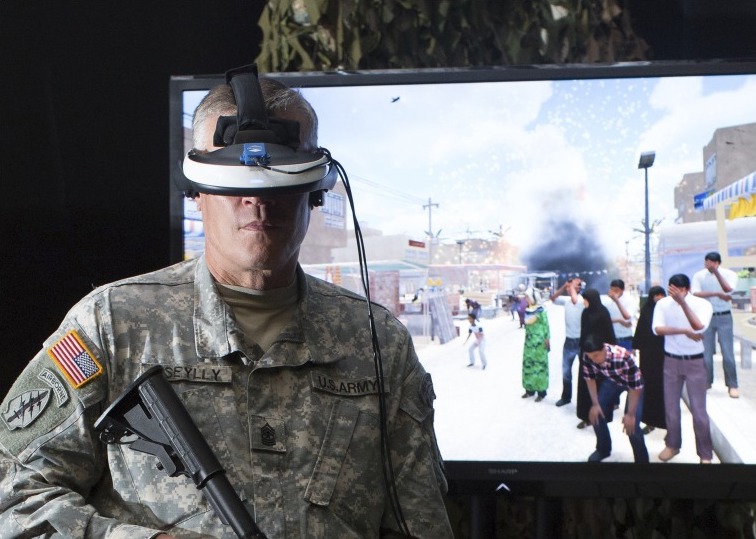
Training for Surgeries
The surgeon relying entirely on his AR glasses during surgery is still rather unthinkable these days, as technology is involved and failures can occur. However, there are some other ways of using AR glasses that are of great advantage and are already being used in some clinics. By being able to maintain all sterile conditions, they can be used to livestream and record surgeries or communicate with other people outside the operating room. The technology is most likely to be used for teaching and training medical students.
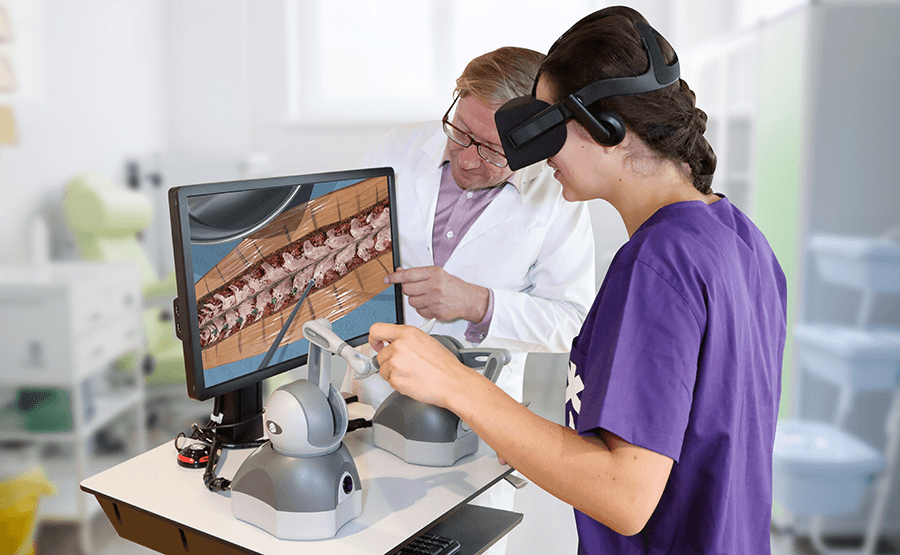
VR for people with visual impairments and those who are completely blind
At a conference in 2019, the SeeingVR toolset was introduced. It is intended to enable people who have poor eyesight or are blind to have virtual reality experiences but without having to create extra newly crafted VR experiences. This tool can be overlaid on top of an existing, traditional VR experience as long as the scenario was created using Unity. The tool works in a flexible way to be able to adapt to as many people as possible and to their needs. The user can adjust brightness, zoom in on elements, change contrast or change text color or size. In addition, objects were given brighter edges to highlight them and contours were given to the scene. A laser can be used to point to a text that is then read aloud.
Embodied Labs to simulate what its like to live with certain health conditions
One company developed labs that use VR simulations to help people experience what it feels like to have certain health conditions. One example of a simulation is Alfred. Alfred is a 74-year-old African-American man who suffers from both high-frequency hearing loss and macular degeneration (a disease of the retina of the eye). Individuals can put on the headset and perceive their surroundings from Alfred’s perspective. Technology is used to increase the volume when a user leans in the direction where the sound is coming from. After a period of time, the user is given a hearing aid to understand what difference the device is making. It is interesting that during tests, even though people read through the introduction, they immediately reported that something has to be broken or that the volume was too low.
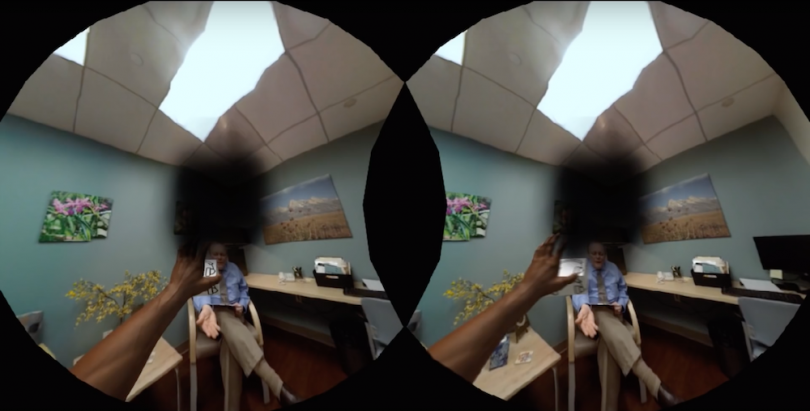
Children with autism are taught social and communication skills
Floreo is a company that focuses on teaching social and communication skills to autistic children by combining VR with games or other activities and letting them practice certain scenarios. Through this method, children who are often overwhelmed by their real environment can practice and learn to cope in a virtual environment.
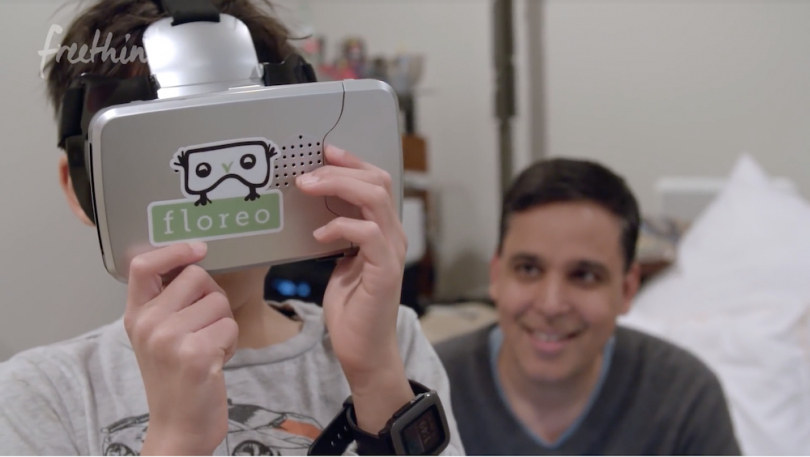
Detect visual impairments through AR
Using AR glasses and eye tracking, the company SyncThink can determine whether and to what extent visual impairments are present.

Unlearning the sensation of pain
The company Karuna helps people to exercise more to have less pain in their upper body or back. Learned pain or chronic pain is to be unlearned through a 12-week course. Common everyday scenarios or activities must be completed with the help of a VR headset and a tablet with instructions.
Improve physical health through VR therapy
Using VR can help people who have psychological problems. An example is fear of heights. Through therapy, a user can be exposed to heights in a protected, simulated environment and learn how to deal with it or try different things. A virtual couch is there to support and help.
Sources
- News Feature: Virtual reality therapy set for a real renaissance, M. Mitchell Waldrop (26.9.2017), https://www.ncbi.nlm.nih.gov/pmc/articles/PMC5625944/
- Using Google Glass in Surgical Settings: Systematic Review, Nancy J Wie, Bryn Dougherty, Aundria Myers, Sherif M Badawy (6.3.2018), https://www.ncbi.nlm.nih.gov/pmc/articles/PMC5861300/
- Microsoft Tools Bring VR Access to Low-Vision, Blind Users, Pamela Hogle (10.6.2019), https://learningsolutionsmag.com/articles/microsoft-tools-bring-vr-access-to-low-vision-blind-users?utm_campaign=lspub&utm_medium=link&utm_source=lspub
- Can virtual reality change the way we think about health?, Gordon Gottsegen (29.6.2019), https://builtin.com/healthcare-technology/ar-virtual-reality-healthcare
- 18 Healthcare Augmented Reality and Virtual Reality Companies to Watch, Kayla Matthews (29.6.2020), https://hitconsultant.net/2020/06/29/augmented-reality-and-virtual-reality-companies-to-watch/#.YBBhVS337ow
- Karuna, (2021), https://karunalabs.com
- Oxfordvr, (2021), https://ovrhealth.com